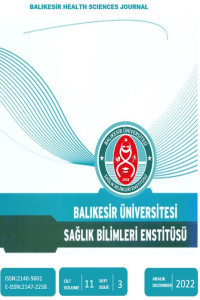ÖN KOLDA İNTRAMUSKÜLER LİPOM
Lipomlar, insan vücudunda en sık görülen benign mezenkimal tümörlerdir. Lipom, yağ dokusundan orijin alan ve en sık rastlanan iyi huylu tümöral oluşum olup vücutta yağ dokusu tabakasının bulunduğu her anatomik lokalizasyonda gelişebilir. Lipomlar genel olarak yüzeyel ve fasyanın üzerinde yerleşimlidirler. İntramuskuler lipomlar malign olma potansiyeli nedeni ile önemlidir. İntramuskuler yerleşimli olguların nüks ve metastas olma özellikleri nedeni ile yakın takibi önemlidir Bu çalışmada intramuskuler lokalizasyonu nedeni ile median sinir bası bulguları olan bir olguya dikkat çekmek istedik.
Anahtar Kelimeler:
İntramusküler lipom, ön kolda lipom
INTRAMUSCULAR LIPOMA OF THE FOREARM
Lipomas are the most common benign mesenchymal tumors of the human body. Lipoma originating from adipose tissue and is the most common benign tumor formation layer of fatty tissue in the body can develop anywhere along the anatomical localization. lipomas, in general, on the superficial fascia and localization. Intramuscular lipomas is important because of the potential to become malignant. Characteristics of the patients due to tumor recurrence and metastasis of intramuscular close monitoring is essential. In this study, we wanted to take care of patient with signs of compression of the median nerve due to the localization of intramuscular lipoma.
Lipomas are the most common benign mesenchymal tumors of the human body. Lipoma originating from adipose tissue and is the most common benign tumor formation layer of fatty tissue in the body can develop anywhere along the anatomical localization. lipomas, in general, on the superficial fascia and localization. Intramuscular lipomas is important because of the potential to become malignant. Characteristics of the patients due to tumor recurrence and metastasis of intramuscular close monitoring is essential. In this study, we wanted to take care of patient with signs of compression of the median nerve due to the localization of intramuscular lipoma.
Keywords:
intramuscular lipoma, lipoma in the forearm,
___
- 1. Fletcher CDM, Unni KK, Mertens F: Adipocytic tumors. In: Pathology and genetics: tumours of soft tissue and bone. World Health Organization classification of tumours. Lyon. IARC Press. pp: 9–46, 2002.
- 2. Dahnert W: Radiology review manual 4th edition. Maryland. Williams & Wilkins. pp: 89, 1999.
- 3. Mori K, Chano T, Matsumoto K, Ishizawa M, Matsusue Y, Okabe H: Type-selective muscular degeneration promotes infiltrative growth of intramuscular lipoma. BMC Musculoskeletaldisorders5:20, 2004.
- 4. Salvatore C, Antonio B, Del Veccio W, Lanza A, Tartaro G, Giuseppe C: Giant infiltrating lipoma of theface: CT and MR imaging findings. Am J Neuroradiol. 24; 283–288, 2003.
- 5. Yoshihara T, Kawano K, Mita N: Retropharyngeal lipoma causing severe dysphagia and dyspnea. J Otolaryngol. 27; 363 –366, 1998.
- 6. Bennhoff DF, Wood CW: Infiltrating lipoma of the head and neck. Laryngoscope 88:839–848, 1978.
- 7. Goldberg BR. Soft tissue sarcoma: An overview. Orthop Nurs 2007;26(1):4-11.
- 8. Murray PM. Soft tissue sarcoma of the upper extremity. Hand Clin 2004;20(3):325-33.
- 9. Datir A, James SL, Ali K, Lee J, Ahmad M, Saifuddin A. MRI of soft-tissue masses: the relationship between lesion size, depth, and diagnosis. Clin Radiol 2008;63(4):373-80.
- ISSN: 2146-9601
- Yayın Aralığı: Yılda 3 Sayı
- Başlangıç: 2012
- Yayıncı: Balıkesir Üniversitesi
Sayıdaki Diğer Makaleler
Mehmet ERDURAN, Sercan ÇAPKIN, Adem KAR, Ahmet KARAKAŞLI, Hasan HAVITÇIOĞLU
Çiğdem KÜÇÜKEŞMEN, Selim ERKUT, Hakkı Cenker KÜÇÜKEŞMEN
Alper AKGÜRBÜZ, Zeynep ÖNCEL TORUN, Fulya TOKSOY TOPÇU
BEYİN CERRAHİ YOĞUN BAKIM ÜNİTESİNDE YATAN HASTALARIN RETROSPEKTİF OLARAK DEĞERLENDİRİLMESİ
Nadide Müge KURUCU, Sevda EFİL, Olcay ESER, Adem ASLAN, Hamit Selim KARABEKİR
VERTEBRA KAYNAKLI DEV RETROPERİTONEAL KİST HİDATİK
İsmail YAMAN, Hayrullah DERİCİ, Gülen DEMİRPOLAT, Mehmet ERDURAN
22 HAFTALIK GEBEDE ABDOMİNAL ATEŞLİ SİLAH YARALANMASI: OLGU SUNUMU
Tolga KARACAN, Cemile İLHAN, Mustafa Üner KARACAOĞLU, Hikmet KOÇER, Taner Abdullah USTA
